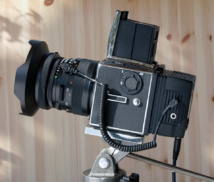
"That's the danger of post-production in digital. People kill anatomy. They have no sense of anatomy. The sense of realism takes away from the sensuality."
D'Orazio, speaking at the opening of a sale in New York of some of his most famous fashion shots, knows a thing or two about beautiful women.
After getting his first job with Andy Warhol, the New York-born photographer went on to become famous for his late 1980s and 1990s pictures of models like Kate Moss, Helena Christensen, Christy Turlington and Eva Herzigova.
The pictures are variously poetic, even sculptural, often smoldering and sometimes borderline pornographic.
D'Orazio, 57, said the supermodel era that he's credited with helping to create is truly over.
"The term started with these girls," he said, gesturing at the huge, provocative prints of models in the private sales gallery of Christie's in Manhattan. "Everybody else is just usurping the title."
His former muses are still world famous, but for the most part have moved on. "They're busy with their kids and that," he said.
But their now iconic images have become "collectible" -- a development he hopes will fuel sales at his Christie's exhibit, titled "Other Graces."
According to D'Orazio, commercial fashion photography is not what it was and the abandonment of film has a lot to answer for.
In film, "there's an emotional quality that the digital loses. Digital creates a facade. Film has depth to it," he said.
"Thank God, I kept all my film cameras. Nobody wanted to buy them anyway."
But a broader loss in quality comes in the shift from the likes of the ethereal Kate Moss to famous-for-being-famous celebrities like Kim Kardashian or Paris Hilton.
It's a "trash" world where "the new pop is porn," said D'Orazio.
D'Orazio dropped out of the fashion frontlines for several years, but said he's found a way to navigate this new terrain while maintaining his integrity: turning porn into art.
In his newest works, which he hopes collectors will discover after being lured in by his conventional fashion images, he took "old '70s porn and scratched out the faces and their privates and what it did was make a moving abstract," he explained.
"As an artist, you basically do a portrait of what you see," he said, referring to Western society's embrace of pornography. "That's what our culture is."
--------------------------------------------------------------------------------------------------------------------
D'Orazio, speaking at the opening of a sale in New York of some of his most famous fashion shots, knows a thing or two about beautiful women.
After getting his first job with Andy Warhol, the New York-born photographer went on to become famous for his late 1980s and 1990s pictures of models like Kate Moss, Helena Christensen, Christy Turlington and Eva Herzigova.
The pictures are variously poetic, even sculptural, often smoldering and sometimes borderline pornographic.
D'Orazio, 57, said the supermodel era that he's credited with helping to create is truly over.
"The term started with these girls," he said, gesturing at the huge, provocative prints of models in the private sales gallery of Christie's in Manhattan. "Everybody else is just usurping the title."
His former muses are still world famous, but for the most part have moved on. "They're busy with their kids and that," he said.
But their now iconic images have become "collectible" -- a development he hopes will fuel sales at his Christie's exhibit, titled "Other Graces."
According to D'Orazio, commercial fashion photography is not what it was and the abandonment of film has a lot to answer for.
In film, "there's an emotional quality that the digital loses. Digital creates a facade. Film has depth to it," he said.
"Thank God, I kept all my film cameras. Nobody wanted to buy them anyway."
But a broader loss in quality comes in the shift from the likes of the ethereal Kate Moss to famous-for-being-famous celebrities like Kim Kardashian or Paris Hilton.
It's a "trash" world where "the new pop is porn," said D'Orazio.
D'Orazio dropped out of the fashion frontlines for several years, but said he's found a way to navigate this new terrain while maintaining his integrity: turning porn into art.
In his newest works, which he hopes collectors will discover after being lured in by his conventional fashion images, he took "old '70s porn and scratched out the faces and their privates and what it did was make a moving abstract," he explained.
"As an artist, you basically do a portrait of what you see," he said, referring to Western society's embrace of pornography. "That's what our culture is."
--------------------------------------------------------------------------------------------------------------------









 Home
Home Politics
Politics









